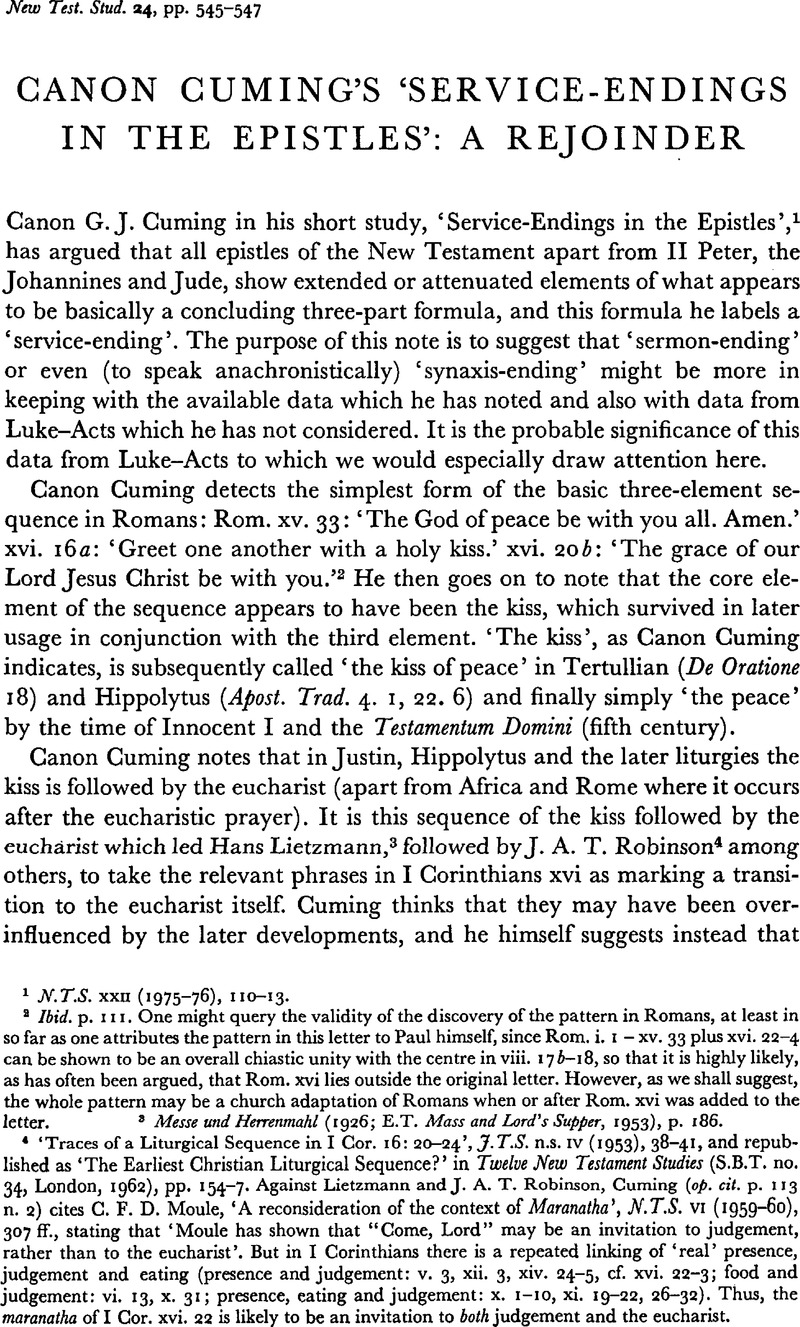No CrossRef data available.
Published online by Cambridge University Press: 05 February 2009

page 545 note 1 N.T.S. XXII (1975–76), 110–13.
page 545 note 2 ibid. p. 111. One might query the validity of the discovery of the pattern in Romans, at least in so far as one attributes the pattern in this letter to Paul himself, since Rom. i. I – xv. 33 plus xvi. 22–4 can be shown to be an overall chiastic unity with the centre in viii. 17b–18, so that it is highly likely, as has often been argued, that Rom. xvi lies outside the original letter. However, as we shall suggest, the whole pattern may be a church adaptation of Romans when or after Rom. xvi was added to the letter.
page 545 note 3 Messe and Herrenmahl (1926; E.T. Mass and Lord's Supper, 1953), p. 186.Google Scholar
page 545 note 4 ‘Traces of a Liturgical Sequence in I Cor. 16: 20–24’, J.T.S. n.s. 4 (1953), 38–41Google Scholar, and republished as ‘The Earliest Christian Liturgical Sequence?’ in Twelve New Testament Studies (S.B.T. no. 34, London, 1962), pp. 154–7.Google ScholarLietzmann, Against and Robinson, J. A. T., Cuming (op. cit. p. 113Google Scholar n. 2) cites Moule, C. F. D., ‘A reconsideration of the context of Maranatha’, N.T.S. 6 (1959–60), 307 ff.Google Scholar, stating that ‘Moule has shown that “Come, Lord” may be an invitation to judgement, rather than to the eucharist’. But in I Corinthians there is a repeated linking of ‘real’ presence, judgement and eating (presence and judgement: v. 3, xii. 3, xiv. 24–5, cf. xvi. 22–3; food and judgement: vi. 13, x. 31; presence, eating and judgement: x. 1–10, xi. 19–22, 26–32). Thus, the maranatha of I Cor. xvi. 22 is likely to be an invitation to both judgement and the eucharist.
page 546 note 1 Op. cit. p. 113.
page 546 note 2 ‘Luke 24: 13–33 and Acts 8: 26–39: The Emmaus Incident and the Eunuch's Baptism as Parallel Stories’, Bangalore Theological Forum, 7, 1 (January-June 1975), 17–31.Google Scholar
page 546 note 3 Acts viii. 36, the eunuch's words, ‘What hinders me being baptized?’ would appear to point to almost an inversion of the examination of baptismal candidates. The implied answer to the eunuch's question is that nothing hinders him, not even his being a eunuch. On κωλύεıν, ‘to hinder’, being used in reference to baptism, see Cullmann, O., Baptism in the New Testament (S.B.T. no. 1, London, 1950), pp. 71 ff.Google Scholar
page 547 note 1 As is argued by Cullmann, O., Early Christian Worship (E.T. of Urchristentum und Gottesdienst, Zürich, 1950; S.B.T. no. 10, London, 1953), pp. 26–32.Google Scholar
page 547 note 2 O'Neill, J. C., The Recovery of Paul's Letter to the Galatians (London, 1972), p. 12Google Scholar, works on the hypothesis that the history of the text of Paul's epistles ‘was a history of continual expansion as explanatory and expository notes were added to the text’. A similar statement may be found in O'Neill's The Theology of Acts in Its Historical Setting (2nd ednLondon, 1970)Google Scholar, an edition not at present accessible to this writer.
page 547 note 3 It is worth noting that there is variable manuscript evidence concerning the greetings of I Cor. xvi. 19, once again in connection with the kiss (I Cor. xvi. 20b).
page 547 note 4 In the case of II Corinthians, the large chiastic units are i. 23–vii. 16 (minus vi. 14–vii. I) with centre at v. 1, viii. 1–ix. 15 with centre in the middle of viii. 22, and x. 1–xiii. 10 with centre in xi. 31. Not only does this support the often-asserted composite nature of the letter, but it makes the ‘peace’, ‘grace’ and ‘kiss’ elements of II Cor. xiii. 11–13 more suspect than ever of being a church addition.